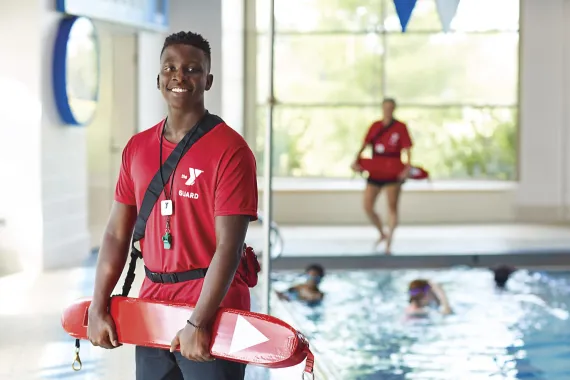During this class, participants will learn life-saving rescue skills for an Aquatic Environment. Once a participant takes the classes and passes the skills and written test, they will be certified as a YMCA Lifeguard for 2 years.
Lifeguard Course Prerequisites
Minimum age of 15 by the last day of the scheduled course. Those under the age of 18 must have parental consent to participate in the course.
Pass the following Physical Competency Requirements (conducted in class on first day or prior to the first day):
- Phase 1 – Tread Water
Tread water (no arms) for 2 minutes without stopping or rest - Phase 2 - Continuous Swim
Swim 50 yards of front crawl
Swim 100 yards of breaststroke
Swim 50 yards of Front crawl with the head up
Swim 50 yards of breaststroke with head up
Swim 50 yards of elementary backstroke kick with eggbeater kick with hands on chest - Phase 3 (No Goggles) - Combined Skills Event
Participants start in the water at shallow end of the pool.
Sprint for approximately 60 feet (20 yards), and then perform an arm-over-arm surface dive in 7 to 10 feet of water (or maximum depth of training facility).
Pick up an object (dive ring) from the bottom of pool, surface, tread water for at least 1 minute with legs only
Swim the remaining length of the pool on your back holding the object with both hands. Place the objects on the deck and hoist yourself out of water.
Immediately begin compression on an adult manikin for 1 minute or 100 compressions; stand and listen to directions from instructor.
Quickly walk over to an elevated lifeguard stand, climb onto lifeguard stand, sit down, look near your feet for a colored shape, and find the matching colored shape while scanning the pool area.
Scan and identify an object located somewhere in the pool area.
Stand up and blow a whistle loud and clearly shout “the Y is great” and then exit lifeguard stand.
Must Be Able To Accomplish These Tasks
- Remain alert, with no lapses in consciousness
- Sit for extended periods, including in an elevated chair
- Move to various locations, including in and around an elevated chair
- Communicate verbally, including projecting the voice across distances
- Hear noises and distress signals in the aquatic environment
- Observe all areas of the aquatic environment
- Perform all needed rescues and survival skills
- Think in the abstract, solve problems, make decisions, instruct, evaluate, supervise, and remember
- Will possess the skills to operate alone as a lifeguard, with or without other lifeguard support.
